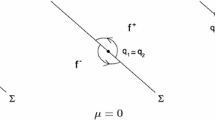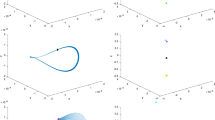Abstract
In this work we study degenerate fold–Hopf bifurcation of codimension three in a differential system of the form
We prove that the classical theory of the fold–Hopf bifurcation cannot be applied for studying the system’s behavior. However, using tools from averaging theory we prove the existence of periodic orbits generated by this bifurcation.
Similar content being viewed by others
References
Giné, J., Grau, M., Llibre, J.: Limit cycles bifurcating from planar polynomial quasi-homogeneous centers. J. Differ. Equ. 259, 7135–7160 (2015)
Llibre, J., Mereu, A.C., Novaes, D.D.: Averaging theory for discontinuous piecewise differential systems. J. Differ. Equ. 258, 4007–4032 (2015)
Llibre, J., Novaes, D.D., Teixeira, M.A.: On the birth of limit cycles for non-smooth. Bull. Sci. math. 139, 229–244 (2015)
Candido, M.R., Llibre, J.: New results on averaging theory and applications. Z. Angew. Math. Phys. 67, 106 (2016)
Francoise, J.-P.: Poincaré–Andronov–Hopf bifurcation and the local Hilbert’s 16th problem. Qual. Theory Dyn. Syst. 11(1), 61–77 (2012)
Kuznetsov, Y.A.: Elements of Applied Bifurcation Theory. Springer, New York (1995)
Tigan, G.: Degenerate with respect to parameters fold–Hopf bifurcations. Discrete Contin Dyn Syst Ser A 37(4), 2115–2140 (2017)
Cid-Montiel, L., Llibre, J., Stoica, C.: Zero–Hopf bifurcation in a hyperchaotic Lorenz system. Nonlinear Dyn. 75(3), 561–566 (2014)
Buzzi, C., Llibre, J., Medrado, J.: Hopf and zero–Hopf bifurcations in the Hindmarsh–Rose system. Nonlinear Dyn. 83(3), 1549–1556 (2016)
Llibre, J., Zhang, X.: On the Hopf-zero bifurcation of the Michelson system. Nonlinear Anal. Real World Appl. 12(3), 1650–1653 (2011)
Efstathiou, K., Liu, X., Broer, H.W.: The boundary-Hopf–fold bifurcation in Filippov systems. SIAM J. Appl. Dyn. Syst. 14, 914–941 (2015)
Rössler, O.E.: An equation for continuous chaos. Phys. Lett. 57A(5), 397–398 (1976)
Han, M., Romanovski, V.G., Zhang, X.: Equivalence of the Melnikov function method and the averaging method. Qual. Theory Dyn. Syst. 15(2), 471–479 (2016)
Buica, A.: On the Equivalence of the Melnikov Functions Method and the Averaging Method, Qualitative Theory of Dynamical Systems. doi:10.1007/s12346-016-0216-x (to appear)
Verhulst, F.: Nonlinear Differential Equations and Dynamical Systems, Universitext. Springer, New York (1991)
Author information
Authors and Affiliations
Corresponding author
Appendix
Appendix
In this section we recall the main results concerning non-degenerate fold–Hopf bifurcations needed to deal with degenerate cases. For more details we refer the reader at [6].
Consider a system in the form
\(x\in {\mathbb {R}}^{3},\alpha \in {\mathbb {R}}^{2},\) f smooth, which has an equilibrium \(x=0\) with the eigenvalues \(\lambda _{1}=\nu (\alpha ),\) \( \lambda =\mu (\alpha )+i\omega (\alpha )\) and \({\bar{\lambda }}\) for \(||\alpha ||=\sqrt{\alpha _{1}^{2}+\alpha _{2}^{2}}\) small enough, such that \(\nu (0)=\mu (0)=0\) and \(\omega (0)=\omega _{0}>0,\) i.e. for \(\alpha =0\) the equilibrium \(x=0\) has a zero and two purely complex eigenvalues. The reader will notice that we write \(x=0\) and \(\alpha =0\) for \(x=\left( 0,0,0\right) \) and \(\alpha =\left( 0,0\right) .\)
Expanding \(f(x,\alpha )\) with respect to x at \(x=0,\) the system (31) reads
where \(a(0)=0\) and \(F(x,\alpha )=O(||x||^{2}).\) The system can be further put in the form
where \(u=\left\langle p_{0}(\alpha ),x\right\rangle ,z=\left\langle p_{1}(\alpha ),x\right\rangle \) and \(p_{0}(\alpha )\in {\mathbb {R}}^{3},p_{1}(\alpha )\in {\mathbb {C}}^{3}\) are two adjoint eigenvectors given by
such that
for all \(||\alpha ||\) small enough. As usual, for any two vectors we have \( \left\langle u,v\right\rangle =\overline{u}_{1}v_{1}+\overline{u}_{2}v_{2}+ \overline{u}_{3}v_{3}.\)
The vectors \(q_{0}(\alpha )\) and \(q_{1}(\alpha )\) are two eigenvectors corresponding to the eigenvalues \(\nu \left( \alpha \right) \) and \(\lambda =\mu (\alpha )+i\omega (\alpha ),\) i.e. \(J(\alpha )q_{0}(\alpha )=\nu \left( \alpha \right) q_{0}(\alpha )\) and \(J(\alpha )q_{1}(\alpha )=\lambda (\alpha )q_{1}(\alpha ).\) We can write
Here
are smooth functions of \(\alpha \) with \(\Gamma \left( 0\right) =\Omega \left( 0\right) =0\) and
are smooth functions of their variables whose Taylor expansions in \(u,z,\bar{ z}\) start with quadratic terms:
Using the changes
where \(\delta _{i}\left( \alpha \right) ,\Delta _{i}\left( \alpha \right) \) are smooth functions, \(\delta _{i}\left( 0\right) =\Delta _{i}\left( 0\right) =0,i=0,1,2,3,\) the system (33) can be further brought to Poincaré normal form. More exactly we have the following Theorem [6].
Theorem 4.1
If (G.1) \(g_{200}\left( 0\right) \ne 0,\) then there exists a locally defined smooth, invertible variable transformation of the form (40), smoothly depending on the parameters, that for \(||\alpha ||\) small enough brings the system (33) in the form
where \(v\in {\mathbb {R}} ,w\in {\mathbb {C}} \) and \(\gamma \left( \alpha \right) ,G_{jkl}\left( \alpha \right) \) are real-valued smooth functions while \(R(\alpha ),H_{jkl}\left( \alpha \right) \) are complex-valued smooth functions such that \(\gamma (0)=0,R(0)=i\omega _{0}.\) Their expressions at \(\alpha =0\) are given below.
If in addition (G.2) \(G_{011}\left( 0\right) \ne 0,\) the Poincaré form (41) can be further reduced to (44) by means of time reparametrization
and transformations
where \(e_{i}\in {\mathbb {R}} ,K\in {\mathbb {C}} \) are smooth functions and \(e_{4}\left( 0\right) =0.\) More exactly, the system (41) is locally smoothly orbitally equivalent near the origin to the system
where \(u\in {\mathbb {R}} ,z\in {\mathbb {C}} \) and \(\delta (\alpha ),B\left( \alpha \right) ,C(\alpha ),E(\alpha )\) are real-valued smooth functions while \(\Sigma (\alpha ),D(\alpha )\) are complex-valued smooth functions (given below for \(\alpha =0\)) such that \( \delta (0)=0,\Sigma (0)=i\omega _{0}.\)
Finally, if (G.3) \(E\left( 0\right) \ne 0\) is satisfied, using the linear scaling \(u=\frac{B\left( \alpha \right) }{E\left( \alpha \right) }\xi ,z= \frac{B^{3}\left( \alpha \right) }{C\left( \alpha \right) E^{2}\left( \alpha \right) }\zeta \) and the time-reparametrization, \(t=\frac{E\left( \alpha \right) }{B^{2}\left( \alpha \right) }\tau ,\) the system (44) leads to normal form:
where \(s=sign\left[ B(0)C(0)\right] =\pm 1\) and
with \(||\left( \xi ,\zeta ,\bar{\zeta }\right) ||^{4}=\left( \xi ^{2}+|\zeta |^{2}\right) ^{2}.\)
This form (45), for (G.4) \(\theta _{0}=\theta \left( 0\right) \ne 0\) and (G.5) the map \(\alpha \longmapsto \beta \left( \alpha \right) \) is regular at \(\alpha =0,\) leads to the truncated normal form
\(\square \)
The coefficients needed above in Theorem 4.1 are:
respectively,
The needed coefficients for our system (2) are:
respectively,
We have also \(\left| h_{101}\right| ^{2}=-\frac{1}{4} \left( a\!-\!1\right) ^{3}\frac{2a+3a^{3}\!-\!1}{a\left( a+a^{2}\!-\!1\right) ^{2}},\) \( \left| h_{011}\right| ^{2}\!=\!-a^{5}\left( 2a-1\right) \frac{\left( a-1\right) ^{3}}{\left( a+a^{2}-1\right) ^{2}}\) and \(\left| h_{002}\right| ^{2}=-a^{2}\left( a-1\right) ^{3}\frac{\left( 2a-1\right) ^{2}}{\left( a+a^{2}-1\right) ^{2}}.\)
Rights and permissions
About this article
Cite this article
Tigan, G. Analysis of Degenerate Fold–Hopf Bifurcation in a Three-Dimensional Differential System. Qual. Theory Dyn. Syst. 17, 387–402 (2018). https://doi.org/10.1007/s12346-017-0241-4
Received:
Accepted:
Published:
Issue Date:
DOI: https://doi.org/10.1007/s12346-017-0241-4




